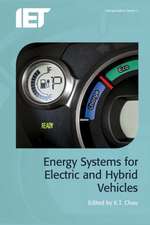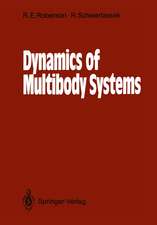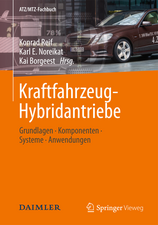Introduction to Modeling and Control of Internal Combustion Engine Systems
Autor Lino Guzzella, Christopher Onderen Limba Engleză Paperback – 28 oct 2014
The discussions concerning pollutant emissions and fuel economy of ICE in automotive applications constantly intensified since the first edition of this book was published. Concerns about the air quality, the limited resources of fossil fuels and the detrimental effects of greenhouse gases exceedingly spurred the interest of both the industry and academia in further improvements.
The most important changes and additions included in this second edition are: restructured and slightly extended section on superchargers, short subsection on rotational oscillations and their treatment on engine test-benches, complete section on modeling, detection, and control of engine knock, improved physical and chemical model for the three-way catalytic converter, new methodology for the design of an air-to-fuel ratio controller, short introduction to thermodynamic engine-cycle calculation and corresponding control-oriented aspects.
| Toate formatele și edițiile | Preț | Express |
|---|---|---|
| Paperback (1) | 893.40 lei 6-8 săpt. | |
| Springer Berlin, Heidelberg – 28 oct 2014 | 893.40 lei 6-8 săpt. | |
| Hardback (1) | 701.11 lei 17-23 zile | +60.63 lei 10-14 zile |
| Springer Berlin, Heidelberg – 15 dec 2009 | 701.11 lei 17-23 zile | +60.63 lei 10-14 zile |
Preț: 893.40 lei
Preț vechi: 1089.51 lei
-18% Nou
Puncte Express: 1340
Preț estimativ în valută:
170.95€ • 178.97$ • 141.45£
170.95€ • 178.97$ • 141.45£
Carte tipărită la comandă
Livrare economică 05-19 aprilie
Preluare comenzi: 021 569.72.76
Specificații
ISBN-13: 9783642424700
ISBN-10: 3642424708
Pagini: 368
Ilustrații: XII, 354 p.
Dimensiuni: 155 x 235 x 19 mm
Greutate: 0.51 kg
Ediția:2nd ed. 2010
Editura: Springer Berlin, Heidelberg
Colecția Springer
Locul publicării:Berlin, Heidelberg, Germany
ISBN-10: 3642424708
Pagini: 368
Ilustrații: XII, 354 p.
Dimensiuni: 155 x 235 x 19 mm
Greutate: 0.51 kg
Ediția:2nd ed. 2010
Editura: Springer Berlin, Heidelberg
Colecția Springer
Locul publicării:Berlin, Heidelberg, Germany
Public țintă
ResearchCuprins
Introduction.- Mean-Value Models.- Discrete-Event Models.- Control of Engine Systems.- Appendices: Basics of Modeling and Control-Systems Theory.- Case Study: Idle Speed Control.- Combustion and Thermodynamic Cycle Calculation.
Recenzii
From the reviews:
"The topic of this book is modeling and control of internal combustion engines for automotive applications. … In summary, this book is an essential text for anyone interested in engine control design. It seems appropriate for a graduate-level course in particular, for students with some control background. According to the authors, the book is intended for students … . I would also like to add that engine control practitioners can also learn a lot from this book … ." (Mrdjan Jankovic, IEEE Control Systems Magazine, December 2005)
"The topic of this book is modeling and control of internal combustion engines for automotive applications. … In summary, this book is an essential text for anyone interested in engine control design. It seems appropriate for a graduate-level course in particular, for students with some control background. According to the authors, the book is intended for students … . I would also like to add that engine control practitioners can also learn a lot from this book … ." (Mrdjan Jankovic, IEEE Control Systems Magazine, December 2005)
Textul de pe ultima copertă
Internal combustion engines (ICE) still have potential for substantial improvements, particularly with regard to fuel efficiency and environmental compatibility. In order to fully exploit the remaining margins, increasingly sophisticated control systems have to be applied. This book offers an introduction to cost-effective model-based control-system design for ICE. The primary emphasis is put on the ICE and its auxiliary devices. Mathematical models for these processes are developed and solutions for selected feedforward and feedback control-problems are presented.
The discussions concerning pollutant emissions and fuel economy of ICE in automotive applications constantly intensified since the first edition of this book was published. Concerns about the air quality, the limited resources of fossil fuels and the detrimental effects of greenhouse gases exceedingly spurred the interest of both the industry and academia in further improvements.
The most important changes and additions included in this second edition are:
• restructured and slightly extended section on superchargers;
• short subsection on rotational oscillations and their treatment on engine test-benches;
• complete section on modeling, detection, and control of engine knock;
• improved physical and chemical model for the three-way catalytic converter;
• new methodology for the design of an air-to-fuel ratio controller;
• short introduction to thermodynamic engine-cycle calculation and corresponding control-oriented aspects
The discussions concerning pollutant emissions and fuel economy of ICE in automotive applications constantly intensified since the first edition of this book was published. Concerns about the air quality, the limited resources of fossil fuels and the detrimental effects of greenhouse gases exceedingly spurred the interest of both the industry and academia in further improvements.
The most important changes and additions included in this second edition are:
• restructured and slightly extended section on superchargers;
• short subsection on rotational oscillations and their treatment on engine test-benches;
• complete section on modeling, detection, and control of engine knock;
• improved physical and chemical model for the three-way catalytic converter;
• new methodology for the design of an air-to-fuel ratio controller;
• short introduction to thermodynamic engine-cycle calculation and corresponding control-oriented aspects
Caracteristici
Description of the mathematical modelling of the physical processes associated with Internal Combustion Engines Provides the model-based controller design and optimization for novel motor technologies
















